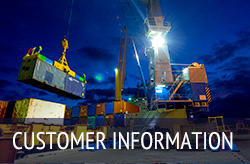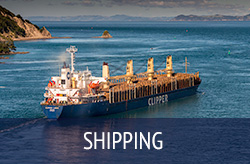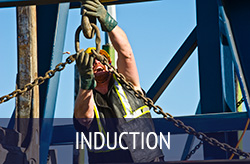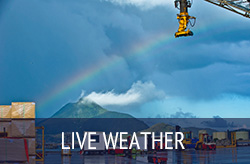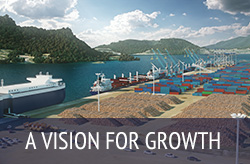Q & As
UPDATED: May 2024
Northport receives many questions from different media on a regular basis, covering a wide range of issues.
In an effort to ensure accuracy and consistency of reporting we publish here the questions we receive most frequently, along with the answers.
For media enquiries please contact:
Peter Heath
Due North Public Relations
E: peter@duenorthpr.co.nz
P: 021 456 089
Discussion over the future of Ports of Auckland
- Is Northport still lobbying for a share of Auckland’s cargo? If so, how?
- Do you disagree with the notion that the Port of Auckland should be shut down and its operations moved elsewhere in their entirety?
- You call for a resilient, geographically astute, three-port supply-chain strategy for the Upper North Island. What does ‘geographically astute’ mean?
- How realistic is it to expect imports to be directed to the Upper North Island port closest to their intended destination? Is that even possible?
- What trends in international shipping are addressed by a three-port supply-chain strategy for the Upper North Island?
- What now needs to be done before an informed decision can be made about a future UNI ports strategy?
- Some industry figures are calling for a study that looks at freight demand over the next 30 years to ensure we have the right capacity, and in the right places. This would include freight modelling - where is export/import demand going to grow? Do you agree?
- Should ports be working more collaboratively and, if so, what needs to happen to make this possible?
- Why has Northport kept such a low profile in the national conversation about moving Ports of Auckland?
Northport has not, and does not, lobby for a share of Auckland’s cargo. Freight will only relocate if the business case stacks up and the customer sees value in the relocation.
Northport supports the wider view of the three Upper North Island ports working collaboratively to better utilise their current and potential footprints to support the Upper North Island’s current and future freight demand. Innovative technology provides for better optimisation of port cargo storage/transit facilities and automation can increase productivity resulting in smoother ship turnaround.
Identification of where the Upper North Island population will grow/relocate and in turn identifying the freight location and/or destination within the area enabling sound decision making with regard to infrastructure requirements; i.e. geographically astute rather than parochial decision making.
High value freight will take advantage of earliest/fastest routes as the product can afford to travel/be multi handled, where the lower value freight will focus on total end-to-end cost. While more focus can be placed on receiving freight at the closest port in reality it will depend on shipping services and frequency.
Reducing the number of international port calls to reduce overall supply chain costs. However, for this to work effectively there is a need for multi-modal efficient supply chains: road, rail, and coastal shipping.
There are two options, allow commercial decision making to drive the outcomes, or undertake a countrywide freight demand study with a focus on the UNI – this will require future population and industry projections and their associated freight growth demand.
Yes – as per above.
New Zealand ports need to work more collaboratively. However ports have to be wary of the difference between ‘working collaboratively’ and ‘collusion’; in our view, relatively recent changes in leadership at ports around the country have created new opportunities to better discuss opportunities within the supply chain.
This has predominantly been a political arena; Northport has remained apolitical throughout and provided through its Vision for Growth factual information about its capability.
Expansion/Vision for Growth
- Northport is on the list of organisations to be considered for inclusion on Schedule 2 of the Fast-track Approvals Bill. Did Northport submit the Eastern Expansion for inclusion?
- How many extra jobs, without the shipyard and floating dry-dock?
- To what extent does the expansion rely on container trade? Is it worth doing for break-bulk only?
- What will be the decision-point for the Board - in terms of both timing and commercial activity?
- Is the project time sensitive?
- What will be the impact of 24hr operations on neighbouring residential areas?
Northport intends to follow the current consent application hearing process to its conclusion. While this remains the company's preferred pathway to obtaining Consent, the deadline of Friday 3 May for applications for inclusion on Schedule 2 of the Fast-track Approvals Bill meant that the company also progressed this option.
At this stage we envisage that the proposed port expansion/container terminal will initially require 50-100 additional jobs at Northport. As the business case allows, the terminal will become semi-automated and then fully automated. Total job numbers will be 30-50 at that time.
The expansion is based on a container trade supporting the Northland and north Auckland freight growth/demand.
As in all Northport expansion plans a solid business case will be required. This can be dependent on both the commercial demand as well as picking the right time to make the investment. As we can demonstrate, the consenting phase can take upwards of five years to complete and is why we started this consent process in 2015.
As per above, the project cannot go ahead without a consent. The time needed to prepare and (hopefully) obtain a consent means the timing of the application is of paramount importance so as to facilitate our ability to react quickly to growth demand.
The port already operates 24/7. There are existing noise management procedures that are reviewed regularly. The proposed shipyard is likely to have conditions imposed around night-time operations such as sand-blasting and painting.
Ship Yard and Dry Dock
- What does Northport have that Picton doesn’t?
- Is the shipyard and dry-dock an essential component of your growth plans?
- Will Northport Ltd invest in the shipyard/floating drydock project?
- Have you seen the final PWC Business Case for the shipyard/floating drydock project?
- Is the shipyard/floating drydock project one of those that the National/ACT/NZ First coalition government intends to fast-track?
- Has Northport submitted this project, or been asked to submit this project, under the ‘fast-track’ infrastructural development legislation?
Northport has not been contracted to consider one port facility over the other, we were asked to consider whether Northport could accommodate a floating dry dock within its future port plans. In doing so we have identified that a floating drydock and associated shipyard facilities need access to significant land based infrastructure, the floating drydock needs access as well as substantial securing infrastructure – these units cannot operate anchored out in the stream; as can be seen from our Vision for Growth plans the proposed infrastructure has sufficient area to support the planned operations. Northland has access to suitable labour and required shipbuilding trades, as well as being able to accommodate any of the shipyard staff moving from Auckland to Northland.
The shipyard/floating drydock is not part of Northport’s own growth plans. Northport is a port operator not a shipyard operator. However the management/shareholders recognised an opportunity for Northport to facilitate significant regional growth and nationally strategic infrastructure.
Northport is a port operator not a shipyard operator. We continue to facilitate discussions with and between potential investors in this regionally significant and nationally strategic infrastructure.
Northport was part of the Advisory Group providing advice during the development of the report but has not seen or been briefed about the content of the report submitted to the Ministry.
That is entirely at the discretion of the government.
‘No’ in both cases. For completeness and full transparency, we have been asked for project information by the government and we have provided this.
Rail
- Do you think the spur will ever happen?
- Is KiwiRail coming to the party, commercially, with competitive rates that will make rail a viable option for cargo heading south?
- Is an Auckland/Northport rail freight service commercially viable right now? If not, what would it take to make it so?
- At what stage, and at what level of detail, are your planning discussions with KiwiRail?
- Where will the rail line go; where will the terminal be situated?
- What do you think about Wayne Brown’s point that rail should run straight to the side of ships?
The rail spur and the port expansion are complementary and both are important to Northport’s ability to play a meaningful role in a resilient and geographically-astute upper North Island supply chain. KiwiRail are in the process of purchasing the last few pieces of land within the designation while confirming the build design. Once this has been completed the actual build is estimated at five years from inception to completion.
Northport is not privy to the commercial rates provided by KiwiRail.
Increased freight volume and either a reduced road-bridge cost or a small container siding at Oakleigh (being discussed with KiwiRail).
Northport meets regularly with KiwiRail, as this project ramps up there are plans for in depth discussions around rail requirements at Marsden Point.
Check out the video on our ‘Vision for Growth’ website , or the slider on this page.
This type of rail configuration is no longer adopted by modern port design; the turnaround times/productivity of ship loading/discharge makes direct to hook delivery impractical, operations need all of the cargo at the port and stacked for multi-port/destination loading before ship arrival.
For discharge the cargo needs to be removed from under hook as soon as landed and taken to storage areas for sorting/stacking for specific destination(s).
Road
- Was ditching the road for the rail the right decision?
- Would you support road development over rail?
Northland requires a multi-modal supply chain, ditching any one for the other makes no real sense if the government really wants Northland as a region to grow. We are happy to see plans to expand the four-laning of State Highway 1 north of Auckland beyond the current termination point at Warkworth.
The rail spur and North Auckland Line upgrade are important to the port’s expansion plans. However, in the interim, linking Northland and Auckland more effectively by road would promote growth within the region; freight, tourism, general business, decentralisation, etc.
Cars
- What’s your position on cars? You spoke some time ago about an alternative business model for the vehicle import trade; what progress?
- You have a job to do, to win over the sceptics in the motor trade. How do you plan to do that?
We continue to work closely with potential customers that see the opportunity to move out of Auckland and are available to mitigate the challenges facing the industry with the capabilities and space we have here. Northport has continued to discuss an alternative to the current car-import model at Ports of Auckland. We are not suggesting a like-for-like operation but an ‘out of the box’ approach whereby cars are imported into Northport and delivered to an adjacent car storage/preparation facility. Then either collected by the customer directly or delivered door-to-door.
Selling the concept relies on ongoing and effective communication with industry players, while working closely with potential customers that see the opportunity to move out of Auckland.
Cruises
- Do you intend to build cruise-specific facilities to become a cruise terminal?
There is no reason for Northport to build a purpose-built cruise facility. The cruise industry is happy to berth alongside a commercial wharf facility, especially if that avoids an anchoring situation and disembarking/embarking by tender.
Log fumigation
- Where can I find more information?
Please see extensive background and additional information here.
Cargo trends
- What are your forecasts for log exports?
- How do you plan to compensate for any slow-down in log exports?
- What are the trends in container traffic at Northport?
In 2014 Northport undertook a review of log availability in Northland, this review identified that log volumes in Northland are expected to remain around 4.2 million m³ per annum until 2026 and then shows a fall to an average harvest availability of c.2.4 million m³ per annum between 2027 and 2041.
Currently log processors use c.1.7 million m³ per annum, this is based on the structural portion of the resource. Based on 40% of the available resources being available to the processors (without any retooling factored in), export log volumes are expected to drop to as low as around 1.4 million m³ per annum over the same period.
This study had a desktop review undertaken in 2018 to confirm accuracy of projections. The review indicated projections were accurate. In 2021/22 a full review was undertaken of the log availability in Northland utilising new technology and most recent harvesting and planting information.
Findings included:
- total annual harvest is projected to reduce gradually from approximately 3.9 million m³ in 2022/2023 to 1.8 million m³ by 2030
- total annual harvest will then plateau for five to six years until approximately 2035/2036 before starting to rise again
- total annual harvest will then peak at up to 6 million m³ by 2045
Northport reviewed its strategic planning in 2015 after the release of the Log Availability Forecast and a study of Northland freight options and made its first move into container handling, which is growing apace. At the same time it introduced its Vision for Growth to the port’s wider community stakeholders.
In recent years there has been an increase in coastal and international container trade. Other export items include kiwifruit, dairy products and manufactured goods. Imports are an important part of Northport’s business and include fertiliser, gypsum, coal and palm kernel. The volume of container traffic increased from 820 TEU in 2016/17 to 32,125 TEU in 22/23.
International Services Shipping lines MSC and CMA have extended their container services linking Northland with Australia, Asia and Europe via the Panama Canal. MSC’s seasonal service to Asia, through Brisbane and Singapore, entered its fifth year in 2023. It is being used extensively by ZESPRI for Northland kiwifruit exports. It is also being used by exporters of other Northland products that benefit from the direct link and refrigerated container space. CMA’s seasonal Panama service to Europe was introduced to Northport during the 2022 Kiwifruit export window; three calls left Northport on a trial basis. The uptake and service was good so frequency was increased in 2023, shipping hundreds of containers of high-value exports from the region direct to the East Coast of the US and Europe. These are valuable direct links to major export markets which Northland businesses can take advantage of. Although they’re seasonal services catering primarily for Kiwifruit exports they are also available to, and have been embraced by, a range of other sectors.
Coastal shipping links In Q1 2024 Pacifica Shipping introduced a weekly coastal shipping container service linking Marsden Point with Tauranga, Auckland and Lyttelton. This enhances the fortnightly service that had been in place since 2016. Northland exporters can have their containers loaded at Northport and just over 12 hours later the ship will be in Tauranga, from where there are daily connections available to almost anywhere. This service also helps Northland importers, and those who want to move freight within New Zealand. This option bypasses any State Highway 1 detours, Auckland traffic and the Cook Strait. This significant move by Pacifica gives shippers more options to reduce their carbon footprint and improve supply chain resilience and efficiency.






